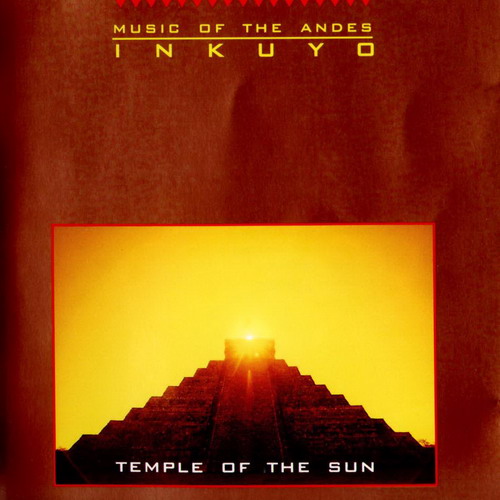|
|
|
01 |
T'iskuy Vicuna |
|
|
|
04:20 |
|
|
02 |
Estampa Tapacarimanta |
|
|
|
06:12 |
|
|
03 |
Sol De Lassana |
|
|
|
03:20 |
|
|
04 |
Coricancha |
|
|
|
05:30 |
|
|
05 |
San Juanito De Medianoche |
|
|
|
03:44 |
|
|
06 |
Sueno Ancestral |
|
|
|
05:41 |
|
|
07 |
Reamita Verde/Huaylash |
|
|
|
04:11 |
|
|
08 |
Azutcena Tika |
|
|
|
05:30 |
|
|
09 |
Danza Chiriguana |
|
|
|
03:29 |
|
|
10 |
Intipampa |
|
|
|
03:43 |
|
|
11 |
Bajo Las Arenas De Pisagua |
|
|
|
05:16 |
|
|
12 |
Tarkeada |
|
|
|
03:12 |
|
|
13 |
Urubamba |
|
|
|
02:26 |
|
|
|
| Country |
USA |
| Original Release Date |
1992 |
| Spars |
DDD |
| Sound |
Stereo |
|
|
|
the project
In the ancient capital city of Cuzco, the Incas dedicated the most magnificent monument of their vast empire to the sun god. Covered with sheets of gold, the temple of Coricancha was as impressive as the deity for whom it was built. For centuries it remained a beacon for pilgrims who traveled from the farthest reaches of the Incan kingdom to witness and assist in the daily ceremonies of Coricancha's priests.
Like the edifice itself, which was plundered and stripped of its golden treasures when the Spanish arrived, the music of those primeval rites has since been lost. The members of Inkuyo, however, have a good idea of how it might have sounded. In Temple of the Sun, they have reconstructed the sounds of festivals hinted at in the myths, memories, and indigenous instruments of the Andean people. These musicians have resurrected the magic and brilliance of the Inca's most venerated temple.
Temple of the Sun does not plunge right into the past. The thirteen selections are designed to take listeners back thoughtfully and joyfully through a combination of modern compositions inspired by the land and its people and traditional songs and dances collected during the band's travels through the Andes. When Inkuyo finally delves into the ancient legacy of Coricancha, their musical reconstructions of Incan antiquity seem logical to listeners as well. Most importantly, Inkuyo has created a portrait of the Inca's past glory that comes to life through the spirit of the people who inhabit the region today.
the artists
An internationally recognized virtuoso of pan-pipes and South American flutes, Inkuyo founder Gonzalo Vargas, inherited his traditional musical knowledge growing up in the remote Andean village of Tapajkari, Bolivia. His desire to perform, study, and teach his ancestral music led him to work with numerous ensembles in his native land. He then played a key role in introducing Andean music to the United States and Canada as one of the founders of Sukay.
In creating Inkuyo, Vargas brought together the talents of three musicians who are well versed in the Andean musical heritage. Pamela Darington studied South American culture in college and has been performing with Vargas since 1983. Both Jorge Tapia and Omar Sepulveda are Chilean refugees who moved to California and became involved with traditional music as a way of remaining close to their roots. Their performances have helped build awareness of the plight of the Chilean people.
An accomplished composer and arranger, internationally recognized virtuoso of pan-pipes and South American flutes Gonzalo Vargas is the founder of the group Inkuyo. Originally a quartet, now a trio, of accomplished musicians bring the ancient instruments and songs of the majestic Andean highlands and of their Incan heritage firmly into the 20th century. Inkuyo takes its name and inspiration from a remote mountain village in the heart of the Andes where the people live as their ancestors have lived for centuries, and where music is an integral part of daily life.
Gonzalo Vargas brings to the group his experiences growing up in the remote Andean village of Tapajkari, Bolivia, where he inherited a rich traditional musical knowledge. After playing with numerous groups in his native land, Vargas brought his passion to perform, study and teach his ancestral music to the United States and Canada. As one of the founders of Sukay, he has played a key role in introducing Andean music to this continent.
While Andean music has become increasingly popular on the international scene, there are few ensembles that can match Inkuyo's expertise, research, and range of music. Devoted to ancient and contemporary Andean music, Inkuyo uses dozens of traditional flutes, whistles, and pipes as well as traditional percussion and strings, to capture the spirit of Andean music.
Joining Vargas in the current Inkuyo line-up includes:
Argentinian guitarist Enrique Coria who for more than three decades has been performing classical, folk and dance music from South America. He has played on hundreds of different recordings with popular groups from Argentina, Chile, Uruguay, Bolivia and the United States. Jose Luis Reynolds, previously a featured guest artist, is the newest member of the group. From Bolivia, Reynolds is a master of the charango, bandurria and tipple.
